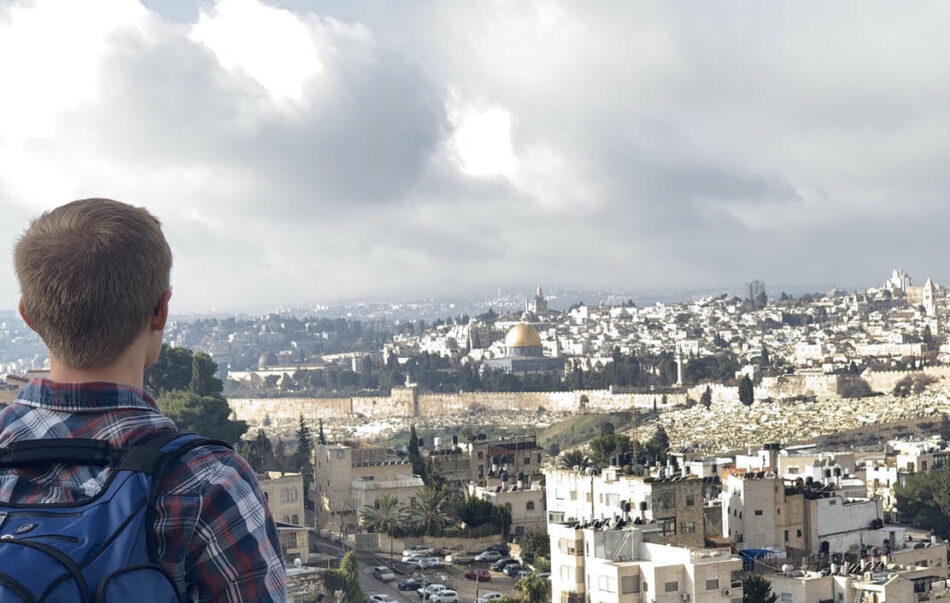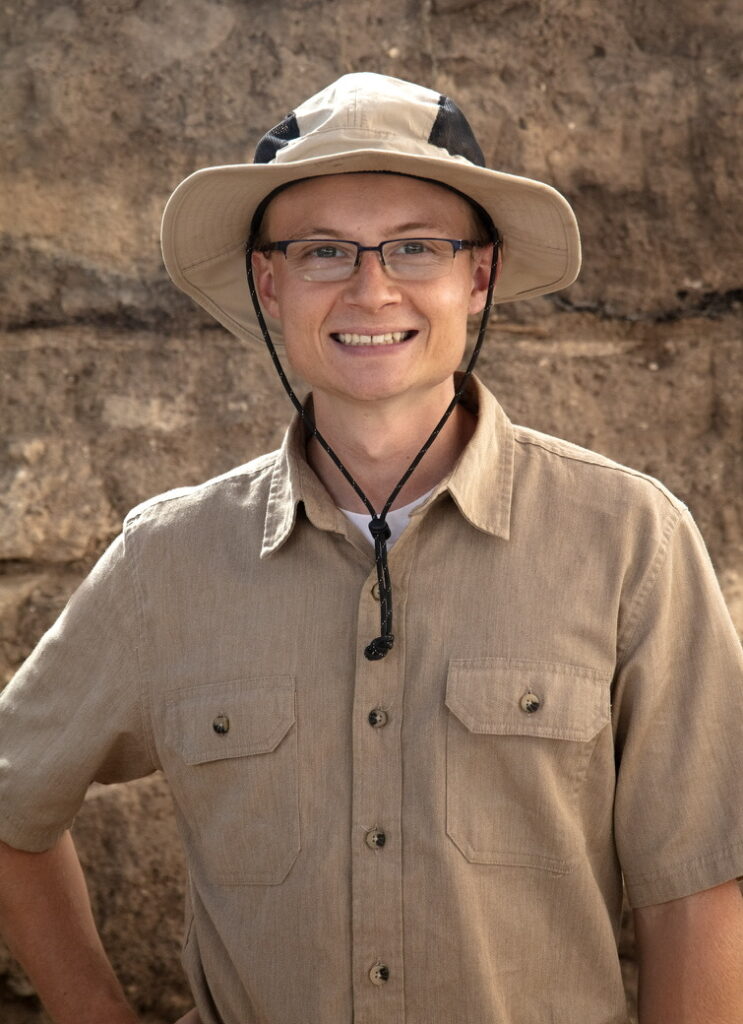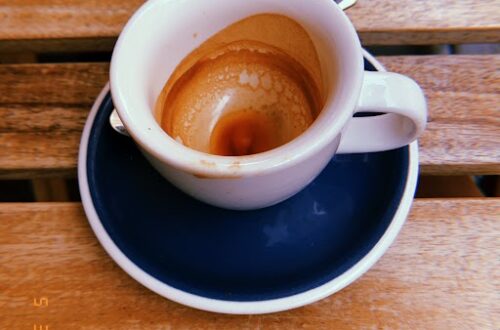
Jerusalem Ostraca
by Isaac James Richards
Photo courtesy of the Author
I visited my grandpa’s grave again yesterday. Easter Sunday. I cannot think of him without thinking of Jerusalem. How the two have fused in my memory. It’s been four years.
I was in Jerusalem on a research trip when the pandemic hit. My institution demanded that I return immediately, more than a month early. When I got on the plane and slipped into my seat, there was a quote floating on the screen in front of me. “A man travels the world over in search of what he needs and then returns home to find it.” Three weeks later, my grandpa died.
Ignore, for a moment, that my Israeli airline replaced seat-back advertisements with a collage of travel quotes, apparently to capitalize on tourists’ nostalgia as they came and went. Also bracket, at least temporarily, the obvious irony of the quote given my forced exodus from Israel and my grandfather’s impending death. What interests me is the way our minds go wild, searching for meaning. Like an animal thrashing about in a cage, mere facts will not do. We start to ascribe reasons where there are none. If I hadn’t come home early for the pandemic, I would’ve missed his funeral.
Coincidence becomes consolation.
Stratum 1: The Stone Age
The day before I flew to Israel, I visited my grandpa. He was slouched in the same chair as always, staring at the television, a bottle of diet Dr. Pepper beside him. Suffering from Alzheimer’s, he had been crumbling for the last few years, his memory eroding. As I bent over to embrace him, he suddenly shook my arms, saying: “I love you! I love you! I love you!” His saggy brown cheeks heaved into a labored grin.
I hadn’t seen Grandpa that energized in months. He probably didn’t even know who I was. He used to whimper when he couldn’t remember something. He’d become embarrassed and frustrated with himself. He must have felt tortured, knowing that the less he fought against his sleepy mind, the faster his entire world would descend into darkness. He was unraveling, wrestling against inevitability, a mounting avalanche of injustice, rocks falling and shattering into dust.
I patted his back and said with a laugh, a cry, and a smile: “I love you too, Grandpa.”
I didn’t know that would be the last time I saw him alive.
As Plato warned in the Phaedrus, writing constrains memory. Thoth, the Egyptian god of writing, created hieroglyphs as a mnemonic tool. But King Thamus was furious, because writing is “an elixir not of memory, but of reminding.” If something is written down, there is no need to remember. We write so that we can forget.
This is perhaps the earliest expression of “the anxiety of the archive.” With time and memory loss, how something is written can become the only way it is remembered—if it is at all. Have you ever read something you wrote about an experience you had since forgotten? Sometimes, by reading, the experience is remembered. Other times, the language is there on the page, but the memory isn’t. I wonder if that is what Alzheimer’s feels like.
Rationally, I understand that my grandfather could not have known that would be the last time we saw each other. But I want to believe that he was saying goodbye. What I don’t know is why I want to believe that. What good it would do. What it would change.
Stratum 2: The Bronze Age
The next day, I boarded a plane for Tel Aviv. The song “Viva La Vida” by Coldplay was playing over the airplane speakers after we landed. Just as a pithy quote would usher me out of Jerusalem, those lyrics seemed uncannily appropriate to welcome me: to the place where Roman calvary choirs sang for centuries and where bells still peal from cathedral towers.
Unsolicited words. Words that confront our bodies. Words that just happen to be swirling around us. We often use these words for meaning making. We try to force serendipity on the strangeness of life.
One of the first new words I learned in Israel was the word “tel.” Nearly every green traffic sign had it: Tel Aviv, Tel Gezer, Tel es-Sultan.
/tel/
noun (archaeology)
a small hill formed by the accumulated refuse of people living on the same site for thousands of years
origin:
tel is the transliteration of a Hebrew word meaning “rubbish heap” and “mound”
The definition was cryptic until I saw an excavation trench at an archaeological park.
“A tel is like a multi-layered cake,” the tour guide explained. “That excavation trench slices the cake so you can see the layers: Canaanite, Ancient Israelite, Philistine, Jewish, Persian, Babylonian, Byzantine, Roman, Christian, Muslim. Layers of history stacked on top of each other.”
All tels, I learned, were once cities, usually biblical ones like Jericho, Dan, or Caesarea. Across history, invaders conquered and destroyed cities of mud, brick, and stone. But cities are strong. Cities endure. Cities are cities because of their proximity to fresh water, soil, and trade routes. So, invaders built over their own rubble, a new city on the prior remains. The history of the Middle East is this cycle, repeated over thousands of years. Conquest, construction. Conquest, construction. Slowly, the city would rise on the ruins of its former editions, and the accumulating heap of destroyed buildings, garbage, rocks, pottery, and dirt would create a landfill, a mound, a monument, a little knoll marking a spot where civilization once stood.
Sometimes, these are places where civilizations still stand.
Israel has hundreds of tels. Some exist out in the countryside as national parks. Others are directly intertwined with urban spaces, below hotels, or next door to an apartment. I marveled at the distinct layers: bricks, dirt, flagstones, mud, more dirt and bricks, boulders, and stone blocks. Some tels have more than twenty different strata. Each occupational layer holds a culture’s memories—their holy places, weapons, art—only to be destroyed by the next marauders who would cover that residue with their rebuilding. Each little mound commemorates millennia of Jewish, Christian, and Islamic history.
Jerusalem itself is a tel. A pile. As with all tels, the lowest layer is the oldest, and the newest layer is on top. Jerusalem’s recent strata is most visible: cigarettes littering the street, dark beards, yellowish stucco, and wrinkled grandmothers selling vegetables on decorative floor-mats. Once I wandered the rooftops of the Armenian Quarter and saw orthodox Jews marching over the rooftops as a new and living layer, tramping routinely over the history and debris below.
Below the contemporary level is Islamic Jerusalem: the Ottoman walls of the Old City, the Dome of the Rock, the minarets. Below that, Christian Jerusalem: churches, mosaics, cisterns. As you go deeper (down a stairway, for instance) you go further back in time. Most of the excavations in Jerusalem are literally underground, beneath streets and offices. If you descend a ramp, you hit Roman paving stones from the time of Jesus. Down more stairs, you can see Hezekiah’s wall. Jerusalem is a dynamic tel, a modern metropolis directly above six thousand years of human habitation. I was now a part of it, a layer all my own, expecting to live in Jerusalem for the entire semester.
I wandered the Old City of Jerusalem almost every day, admiring gray clouds, beige walls, the rise and fall of the Kidron valley, flies flitting about succulent grapes and dates laid out to dry. I was bombarded by shades of violet, jostled by robed priests, serenaded by honking, stung with the aroma of deep-friend chickpeas, and even shocked by a burst of heat to my face as I passed an unnoticed grill flame. Sunshine doused the golden Dome of the Rock, making it sparkle above old stones. When I walked through the security checkpoint onto the Temple Mount plaza, it felt like entering a Latter-day Saint temple. The spacious architecture, the color white, and the silence—they felt familiar.
Stratum 3: The Iron Age
After he retired, Grandpa was asked to serve as a temple worker—a position in the lay ministry of the Church of Jesus Christ of Latter-day Saints. He was already losing his memory then, making it hard for him to memorize all the ritual language. Despite his growing forgetfulness, he served out of duty and without complaint.
Before he died, Grandpa was just a heavy body with a mental shadow of who he once was. He used to collect and restore old cars: the cream and chrome 1957 Ford Thunderbird hardtop, the baby blue 1966 Ford Mustang convertible, the gray 1930 Model A Ford Roadster with a rumble seat, and the classic 1929 Model A Ford pick-up truck. They share an oversized garage with a rusted maroon racecar, thirty restored gas pumps, over 150 signs, and other memorabilia. He spent his golden years in that garage, tinkering away with his tools, his plaid shirt covered in grease, restoring dents, rust, and trash into pristine, glossy monuments of a former glory. Sinclair. Conoco. Phillips 66. Grandpa had a knack for making glistening memorials out of twisted metal scraps.
Tools and trash. The Israel Museum is full of them. It’s like my grandpa’s garage—except it’s a monument to the Ancient Near East instead of to cars and gas pumps. The museum begins in the Chalcolithic Period, where you can find the prehistoric ancestors of my grandpa’s wrench: a few slightly sharpened pebbles and a partially decomposed stick. Almost nothing is complete in the museum. Everything is broken. Each exhibit is decorated with dozens of orange pottery shards—piles of them. Many of these pottery shards have writing on them. When they do, they are known as ostraca. What an artful way to use brokenness—to write on the pieces. I think my grandpa would’ve gotten along well with archaeologists; they enjoy rummaging around in junk piles, finding antiques, and then dusting them off, restoring them, placing them on a shelf for all to admire. My grandpa liked doing that: putting things back together.
My grandpa started the Morgan Valley Car Show a decade ago. Every July, car-lovers from all over Utah would come to show off their rides. Guests gobbled hot dogs, baked beans, and orange creamsicles. My grandma packed three coolers with Coke, Pepsi, and Diet Dr. Pepper, each in cherry flavor too. My cousins and I used to wander in awe, our faces smeared with ketchup and creamsicles, as the sun shimmered off the painted hoods: neon red, glittering emerald, and sparkling sapphire.
One day, in Jerusalem, I walked through a courtyard where a dozen Jewish boys with mini kippahs on their heads were playing soccer. Then I saw a plaque. In that very courtyard, dozens were killed, and hundreds taken prisoner during the Six-Day War in 1967. I imagined what lay below the pavement where boys played soccer now, their prayer shawl tassels bouncing as they ran. Another layer of blood and destruction on the pile.
At Yad Vashem, a Holocaust Museum in Jerusalem, I learned about a concentration camp prisoner who was caught using a sack as an extra undershirt. As punishment, he was required to stand between two barbed-wire electric fences in freezing weather, knowing that if he fell asleep, he would fall into one. He played chess in his mind to stay alert, and then had to pee, but tried to not pee as evidence that he was in control of himself. When he finally urinated, he said it was a relief from the cold to have the warm urine running down his legs—until it froze.
I wonder if that was what dementia felt like for Grandpa: playing chess in his mind to stay alert, using his mental light to pierce a growing mist. I’m not comparing Alzheimer’s to the Holocaust, nor my grandpa’s experience to that prisoner’s. I can’t help but recognize the chess connection, though, because Grandpa was a chess master. During his years as a computer programmer, he played chess during his lunch break every day for years. Looking up from a book of Sudoku, he told me that he liked playing games because they kept his mind sharp; it was a way to fight his deteriorating memory.
Stratum 4: The Babylonian Exile
I don’t have Alzheimer’s (yet), but within four years I have forgotten most of the sites I visited in Israel. The details, the dates or place names, weren’t meaningful on their own. It was the whole heap. The holistic experience was unforgettable, not the minutia. Our days layer on top of each other—rich, complicated, diverse, profound, and meaningful. Nearly all experiences become indistinct in memory, but we retain scraps, bits, and shards. Writing is a way of restoring memories, dusting them off, polishing them with a fresh coat of language.
Stratum 5: The Meridian of Time
My grandpa’s favorite hobby was flyfishing. He taught my brothers and I on the river that bordered his property. I loved watching him split the deep green water with his neon line. He caught thousands of fish but maintained a strict personal policy of catch-and-release with non-barbed hooks—a practice that was gentler on the fish but made fishing more challenging. He kept a catch log: species, length, time of day, stream.
Grandpa could tell if a river was deep or shallow just by the color of cloud shadow on the water. Grandpa could predict how many fish would bite by the weather, time of day, humidity, and season. Grandpa tied his own flies, fixed his own rods, and was as handy in the tacklebox as he was in his toolbox. I have one clear memory of him emerging from the river, tan waders dark with wet, stepping reluctantly, as though he belonged in those swirling eddies. I can’t tell if this memory is of a single event, or just a composite image of our time at the river.
The Greek word for fish is ichthys, and the Greek symbol looks like an outline of a trout. During the Roman period, it was a Christian secret symbol. Seven of Christ’s apostles were fishermen. He called them after filling their boat with net-breaking hordes of fish from the sea of Galilee. Christians revere Galilee as a must-see highlight for tourists and pilgrims. A visit to the Galilee is a visit to the New Testament: Capernaum, Nazareth, the Mount of the Beatitudes.
I planned to spend several weeks in the Galilee. One week before I would have visited, there was an outbreak of COVID-19 in Bethlehem.
Stratum 6: Late Roman Period
On my last day in Israel, I stood on my apartment balcony and stared at the wall that circles Jerusalem, built by Ottoman Sultan Suleiman the Magnificent. I had become so attached to this place, a place so rich in history and culture. Unactualized opportunities stabbed at my brain. I wanted to see spring. I wanted to see the flowers bloom. I had so many empty and unfinished notebooks—
“A man travels the world over in search of what he needs and then returns home to find it.” What frustrating thing to read when departing a curtailed journey. Those words continued to haunt me in the months after my grandpa’s passing. They come from George Moore’s novel The Brook Kerith, which retells the Jesus story as realistic fiction. For Moore, Jesus was a regular man who survived his crucifixion, and the supernatural mythology that developed around his story is nothing but legend. Strange, don’t you think, that a book like that would be quoted on a plane screen as I flew away from birthplace of the three largest monotheistic religions in the world? And strange how those few words, plucked completely out of context, could launch me on a journey of meaning-making, layered with my grandfather’s life, religion, and memory.
Stratum 7: Early Islamic Period
While in Jerusalem, I spent a day covering two full-length whiteboards with a timeline of the Ancient Near East from 7000 B.C.E. to the present. I wanted to get my temporal bearings in a place where the weight of history crushes. Distinctions between the Early, Middle, and Late Bronze Ages are debated by scholars. Biblical chronology is even messier. Even the headings I’ve chosen here are imperfect, general, and selective. I dated the Second Temple Period, the Hellenistic Period, and on through the Israeli War of Independence in 1948. The day I constructed the timeline was January 13, 2020, and I marked it as the far end of the chronology with a news headline I saw that morning: “Jeopardy mistakes Bethlehem for being in Israel, not Palestine.” Just before I returned home, the Israeli elections resulted in a third sequential stalemate: history in the making. Now Gaza. The unspeakable. The endless daily deaths.
Here’s another timeline: (1) Early on a weekday morning, my grandma installs my grandpa in a care facility. He’s too heavy for her to lift, and he can no longer bathe himself. (2) She reassures him that she will be back soon, she is just going to get some pictures for his room. (3) Grandma arrives home to gather up the photographs. (4) The governor mandates a lockdown policy. (5) The care facility calls my grandmother to inform her that she will not be able to return to see her husband; the policy now forbids visitors. (6) My grandpa is alone, confined to a strange new room, with no photographs and nothing familiar to support his failing memory. (7) His Alzheimer’s accelerates. (8) Days later, he dies. She never saw him again.
She didn’t know, when she left for the pictures, that it had already been the last time.
Stratum 8: The British Mandate and the State of Israel
Two years ago, I returned to Israel—this time on an archaeological excavation. I realized many flaws in the popular imagination of archaeology but one of them is this: archaeologists do not dig through nothing to find something. All the layers matter. Archaeologists sift through time, dirt, and material remains while recording everything. Then they publish what they learn. The problem is that tels, like our lives, do not offer neat and tidy narratives. Often, all we have is a mound of refuse to sort through.
In the end, chronology and memory are all we have. Chronology is the only unfailing way to unify disparate life experiences. The miracle of human consciousness—the fact that I wake up each day and remember yesterday—that sense of sequence is bedrock for “the self.” And beside oblivion, the only alternative is to be dug out of an archive or the ground. That’s checkmate. Perhaps this is where the impulse to write comes from. We fear that all we are is what we leave behind: piles of words, shards of pottery in the dirt.
Stratum 9: The Divided City
There was no funeral. We did hold a small COVID-19 accommodated graveside gathering, though. A strange feeling hovered at the mortuary. Everyone stayed six feet apart from each other, wearing facemasks. I was one of the pallbearers. The weather was perfect for celebrating death. The sky was slate. The wind was gray. The grass was yellow, brown, and dead. With family members, I helped align the casket so that grandpa’s head faced west, feet to the east, so he could rise and face Jesus in the resurrection. My mom, his only daughter, offered a graveside prayer. Cold tears in the wind at the graveyard.
If I had known my grandpa was dying, I might have returned from my trip voluntarily. Then again, I could have easily justified staying in Jerusalem, even if it meant missing the non-funeral. I hesitate to think what choice I might have made. In some ways, the fact that the choice was made for me—that it was out of my control—made it an opportunity for meaning-making, a “why” for my early return. These are the mind games we play. If I had stayed in Israel, I may have constructed meaning around my grandfather’s death from where I was at the time: in the cradle of Christianity. Galilee, the place I never arrived, is the place of resurrection.
I lingered at the edge of the grave. Grandpa, who spent so many hours restoring deteriorated metal, eventually met with that same death, decay, and destruction that is piled up in the tels of Jerusalem. He died of a destroyed memory. They lowered the casket. My memory was aflame, recycling moment after moment with him. My thoughts filled with the shards of his life: chess pieces, steel scraps, slippery trout, sparkly paint, white temple clothes, and river water. Trembling, I gently dropped a yellow blossom on his mahogany casket with the rest of my family, covering him with a final layer of flowers, soon to be buried under a mound of dirt.
Stratum 10: The Present
My family holds a Christianized seder service to celebrate Passover. The older I get, the more I cringe at cultural appropriation, even if motivated by holy envy. But my nephews love it. They wear yarmulkes, lift their Dixie cups of grape juice, and repeat after their mother, praising the King of the Universe, creator of the fruit of the vine. They dip parsley in salt water, contort their faces after tasting horseradish.
I look out the rainy window and remember Jerusalem. I hear thunder, think of bombs. This year, they’ve asked me to share some photos from my trip. What am I supposed to tell them? That the Garden Tomb so beloved by Protestants dates to eight hundred years before Christ? That the West Bank is under military occupation? That there’s archaeological evidence of Roman crucifixion methods—a heel bone skewered by a rusty stake?
The youngest nephew, just three years old, clambers into my lap. With my phone connected to the TV, I swipe through images of Jerusalem, olive trees, tombs. He points at the screen, chirping and cooing.
On my grandpa’s gravestone, my grandma has placed a tiny plastic model of an antique gas pump. I inherited his watch, a reminder of time. And at home, I have a fragment of a Roman storage jar, given to me by the dig ceramicist. A piece of a rim, curved, no bigger than my finger. Terra cotta orange. How many lips have been pressed against its edge? When I bring it close—faint scent of earth—I can hear one of the archaeologists quoting a psalm: “If I forget thee, O Jerusalem… let my tongue cleave to the roof of my mouth.”

Isaac James Richards researches and writes about religious memory in the Middle East. He spent a semester abroad at the Jerusalem Center for Near Eastern Studies and dug for a season with the Huqoq Excavation Project in Israel. He has published poetry, prose, and peer-reviewed scholarship in several venues from Oxford Magazine to The Journal of American Culture. He is also a Pushcart Prize nominee and will begin a PhD program in the fall at the Pennsylvania State University. Find him online at https://www.isaacrichards.com/.




